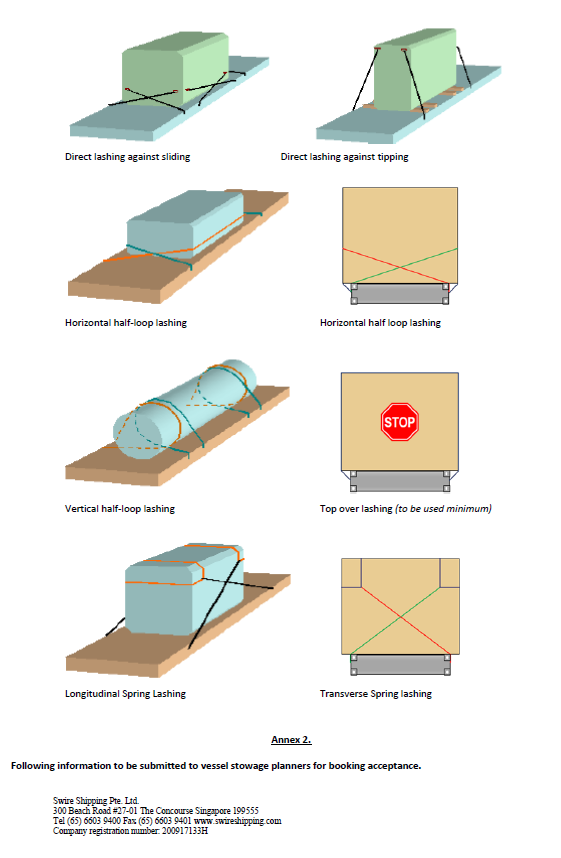客户建议
货物操作循环 参考编号 CMSWM0392017(第4版)
平柜验收
使用平柜运输的货物必须妥善堆放并加以固定,遵守适用的国际和国内法规,包括国际海事组织(IMO)/国际劳工组织(ILO)/联合国欧洲经济委员会(UNECE)的《货物运输单元包装操作规范》(2014 年)和国际海事组织(IMO)的《货物堆放和固定规范》。
鉴于此,
- 额定货物必须均匀地分布在装载板上。 应通过在纵向 H 形梁上铺设垫层来提高集中荷载。 可能有必要酌情用坚固的木梁或钢梁支撑货物,将重量转移到角柱上。
- 在摆放货物时,应使其重心更靠近扁平柜的长度和宽度中间。
- 装在平板架上的货物不得遮挡顶角铸件,如果平板架需要在甲板下的单元导轨舱内装载,则货物和相应的阻挡/支撑材料应堆放在距离平板架角柱 30 厘米的范围内。
在固定货物单元时,必须在纵向底部 H 型大梁的外侧焊接牢固的绑扎环和支架,根据标准,其最大固定载荷 (MSL) 至少为 30 kN,还必须有 MSL 为 50 kN和 100 kN 的额外绑扎点。
– 考虑到要固定的货物重量,所有绑扎材料都必须是经过批准的类型、合适的尺寸和容量。
– 设备两侧的绑带数量必须保持一致,绑带应由相同的部件组成,以便弹性相同。

根据经验来看, 货物单元两侧(左舷和右舷)固定装置的最大固定载荷 (MSL) 值总和应等于单元重量的 2.5 倍。
必须结合使用“首选绑扎方法”(见附件 1),以抵御纵向和横向的滑动和倾覆力。
➢直接绑扎:可防止滑动和倾倒,但需要在货箱上设置牢固的固定点。
➢环形绑扎:防止横向滑动和倾倒,但必须成对使用。
➢弹簧绑扎:防止纵向滑动和倾倒。
➢顶部绑扎:仅增加摩擦力(用于海上运输时最小值)
货物还可以通过在平板架的端壁上加支撑物在纵向上固定。
- 必须在绑带与货物、其他绑带或扁平货架本身的结构接触的任何部位安装适当的“防磨损装置”和“软化剂”,以防止绑带损坏或过度磨损,进而导致失效。
- 任何放置在侧面钢梁上的货物都必须用橡胶、木头或类似的防滑材料隔离。
- 在货物超过高度、长度和宽度时,应保护并标记突出尺寸。
- 如果包括包装、固定和绑扎材料在内的总宽度不超过 2438mm,则货物宽度将被视为“等宽”。
- 如果总长度(包括包装、固定和绑扎材料)不超过 5,618 mm(20’FR)和 11,652 mm(40’FR),货物将被视为“等长”货物。
- 如果货物的整体高度(包括包装、固定和绑扎材料)不超过直立时的端柱高度,因此不妨碍集装箱积载,则以上高度将被视为“等高”。
- 端头向下的平架将被视为 OOG。
装运前的要求:
在用平柜运输货物时,太古轮船要求船只出示由持照货物检验师签发的绑带证书。
为避免货物停运和额外费用,必须在货物装载前提交绑扎证书。
附录 1
首选绑扎方法

附录 2
向船舶积载计划员提交以下信息,以便接受预订。

请注意以下几点:
1. 附上货物照片和绑扎证书。
2. 备注:包括特殊处理要求(如有)
3. OOG 平板架如发现捆扎不牢,应在装货前拒收。
4. 货物的摆放应使其重心更靠近平托架集装箱的中长和中宽,以避免失衡。
5. 扁平货架上装载的货物不得遮挡顶角铸件。
6. 所有仪表内货物必须两端朝上堆放在平板架上。
